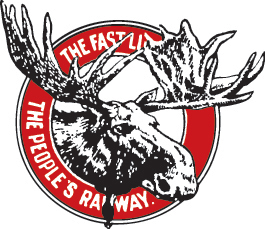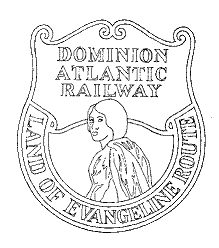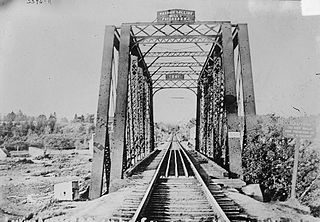
Mattawamkeag is a town in Penobscot County, Maine, United States, located where the Mattawamkeag River joins the Penobscot River. The population was 596 at the 2020 census. The village of Mattawamkeag is in the southwestern part of the town.
Vanceboro is a town in Washington County, Maine, United States. The town was named after landowner William Vance. The main village in town is located at the eastern terminus of Maine State Route 6. Vanceboro is across the St. Croix River from St. Croix, New Brunswick, Canada, to which it is connected by the Saint Croix–Vanceboro Bridge. Vanceboro is also connected to St. Croix by the Saint Croix–Vanceboro Railway Bridge, which is used by the New Brunswick Southern Railway.

The Intercolonial Railway of Canada, also referred to as the Intercolonial Railway (ICR), was a historic Canadian railway that operated from 1872 to 1918, when it became part of Canadian National Railways. As the railway was also completely owned and controlled by the Government of Canada, the Intercolonial was also one of Canada's first Crown corporations.

The Maine Central Railroad was a U. S. class 1 railroad in central and southern Maine. It was chartered in 1856 and began operations in 1862. By 1884, Maine Central was the longest railroad in New England. Maine Central had expanded to 1,358 miles (2,185 km) when the United States Railroad Administration assumed control in 1917. The main line extended from South Portland, Maine, east to the Canada–United States border with New Brunswick, and a Mountain Division extended west from Portland to St. Johnsbury, Vermont, and north into Quebec. The main line was double track from South Portland to Royal Junction, where it split into a "lower road" through Brunswick and Augusta and a "back road" through Lewiston, which converged at Waterville into single track to Bangor and points east. Branch lines served the industrial center of Rumford, a resort hotel on Moosehead Lake and coastal communities from Bath to Eastport.

The Dominion Atlantic Railway was a historic railway which operated in the western part of Nova Scotia in Canada, primarily through an agricultural district known as the Annapolis Valley.
The New Brunswick Railway Company Limited (NBR) is currently a Canadian non-operating railway and land holding company headquartered in Saint John, New Brunswick that is part of Irving Transportation Services, a division within the J.D. Irving Limited (JDI) industrial conglomerate. It is not to be confused with another JDI company, New Brunswick Southern Railway (NBSR), established in 1995, which is an operational railway and considered a sister company of the NBR.

The International Railway of Maine was a historic railroad constructed by the Canadian Pacific Railway (CPR) between Lac-Mégantic, Quebec, and Mattawamkeag, Maine, closing a key gap in the railway's transcontinental main line to the port of Saint John, New Brunswick.

The Atlantic was a passenger train operated by Via Rail, serving both Canadian and U.S. territory between Montreal, Quebec and Halifax, Nova Scotia. It was previously operated by Canadian Pacific Railway as The Atlantic Limited between Montreal and Saint John, New Brunswick. It formed part of the transcontinental service for both systems.

The New Brunswick Southern Railway Company Limited is a 131.7 mi (212.0 km) Canadian short line railway owned by the New Brunswick Railway Company Limited, a holding company that is part of "Irving Transportation Services", a division within the industrial conglomerate J.D. Irving Limited.

The Nova Scotia Railway is a historic Canadian railway. It was composed of two lines, one connecting Richmond with Windsor, the other connecting Richmond with Pictou Landing via Truro.

The Canadian Atlantic Railway (CAR) was a Canadian and U.S. railway that existed from 1988 to 1994.

The history of Moncton extends back thousands of years, with its first inhabitants being the First Nations of the region, such as the Mi'kmaq. Located in New Brunswick, Moncton's motto is Resurgo, which is Latin for I rise again. This motto was originally chosen in celebration of the city's rebirth in 1875 after the recovery of the economy from the collapse of the shipbuilding industry. The city again lived up to its motto in more recent times, when the economy of the city was devastated once more during the 1980s as a result of the city's largest employers all departing the city in short order. The city has since rebounded due to growth in the light manufacturing, technology, distribution, tourism, and retail sectors of the economy and is now the fastest growing city in Canada east of Toronto.
St. Croix is a rural community in York County, New Brunswick, Canada.
The Fredericton Branch Railway is an historic Canadian railway that operated in New Brunswick.
The Eastern Maine Railway Company Limited is a 99.5 mi (160.1 km) U.S. short line railroad owned by the New Brunswick Railway Company, a holding company that is part of "Irving Transportation Services", a division within the industrial conglomerate J.D. Irving Limited.

The Saint Croix–Vanceboro Railway Bridge is a 100-foot-long (30 m) railway bridge crossing the St. Croix River from St. Croix, New Brunswick, Canada, to Vanceboro, Maine, United States. A deck truss design, it is owned and operated by the New Brunswick Southern Railway.
The Gull was an international passenger train service between Boston, United States, and Halifax, Canada, which operated from 1930 to 1960. Journey time was approximately 24 hours. Westbound trains left Halifax shortly after breakfast and crossed the Canada–United States border in the late evening, as eastbound trains were leaving Boston's North Station to cross the border about dawn. Travel was over the Boston and Maine Railroad from Boston to Portland, Maine, then over the Maine Central Railroad to the border between Vanceboro, Maine, and Saint Croix, New Brunswick, then over the Canadian Pacific Railway to Saint John, New Brunswick, and over the Canadian National Railway to Halifax.
The lines of the Canadian Pacific Railway operated in the State of Maine were set up as a separate company to comply with Interstate Commerce Commission regulations and were considered a Class I U.S. railroad. The company operated 234 miles in Maine.

The Maine Central Railroad Company main line extended from Portland, Maine, east to the Canada–US border with New Brunswick at the Saint Croix-Vanceboro Railway Bridge. It is the transportation artery linking Maine cities to the national railway network. Sections of the main line had been built by predecessor railroads consolidated as the Maine Central in 1862 and extended to the Canada–US border in 1882. Through the early 20th century, the main line was double track from South Portland to Royal Junction, where it split into a lower road through Brunswick and Augusta and a back road through Lewiston which converged at Waterville into single track to Bangor and points east. Westbound trains typically used the lower road with lighter grades, while eastbound trains of empty cars used the back road. This historical description does not include changes following purchase of the Maine Central Railroad by Guilford Transportation Industries in 1981 and subsequent operation as part of Pan Am Railways.

The Maritime Express was a Canadian passenger train. When it was launched on 1 March 1898, it was the flagship of the Intercolonial Railway (ICR) between Halifax, Nova Scotia and Montreal, Quebec. The train was operated by the Canadian National Railway (CNR) from 1919 until 1964, when it was reduced to a regional service and its name retired.















